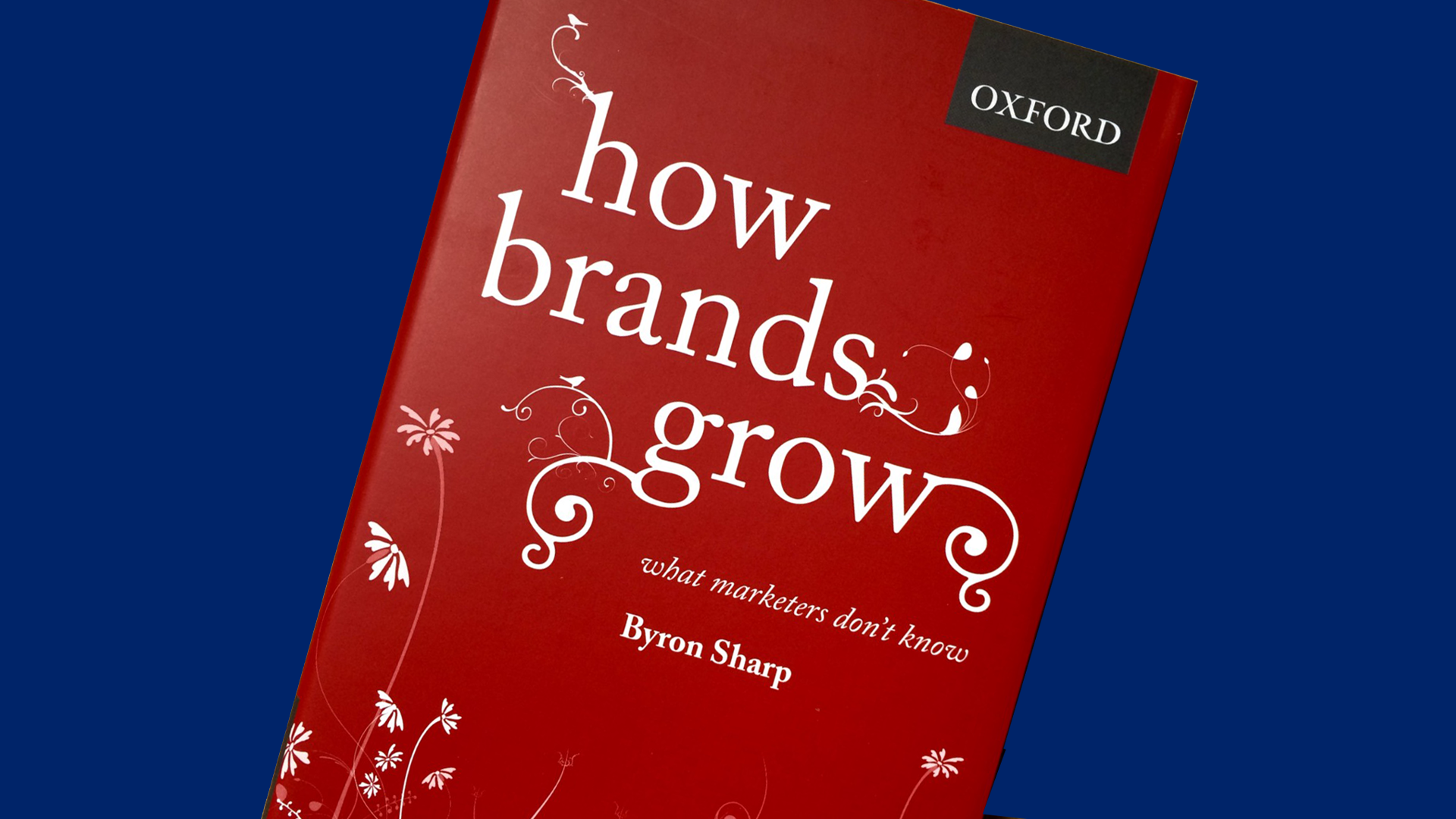As one of the premium creative marketing agencies in London we love to see the research processes behind powerful marketing strategies and evidence based solutions. From psychological approaches to understanding consumer behaviour to tried and tested research into how brands can grow, we’ll be taking a look at some of the most influential books in the marketing industry and share our own takes.
As we face the winter and start to spend more time indoors, the team here at Hub thought it would be the perfect opportunity to review the marketing books that we’ve been reading. Over the next few months, we’ll be discussing major themes, key takeaways and an evaluation of some of the biggest marketing books, both old and new.
We’re kicking things off this month with Byron Sharp’s How Brands Grow which aims to take an evidence-based approach to marketing. As a Professor of Marketing Science, Sharp and his colleagues at the Ehrenberg-Bass Institute were keen to move away from traditional beliefs in marketing which were based on assumptions, arguing that marketing practice should be based on evidence from marketing science. Using this evidence, he outlines 7 rules for brand growth, arguing that brand distinction is the key to growth rather than brand differentiation.
Outline
- Summary of How Brands Grow
- Sharp’s 7 principles for marketing
- Key takeaways
- Critical response to How Brands Grow
- Our verdict
- The bottom line
Summary of How Brands Grow
“Marketers shouldn’t just blindly follow marketing myths because they’re conventional or because they might’ve worked out at some point in the past. Instead, they should consider the empirical evidence of marketing science and do what’s already been proven to work, as this will increase their chances of success.”
Frustrated at the way marketers were working on the basis of long-held conventional beliefs rather than empirical evidence, How Brands Grow aims to set the record straight on how marketing science can help brands to grow. The book starts out by debunking some traditional marketing beliefs, using scientific research to disprove these commonly held misconceptions. These include beliefs surrounding brand loyalty, differentiation, and segmentation.
Sharp’s 7 principles for marketing
- Continuously reach all of the buyers within your category via both marketing communications and physical distribution
- Ensure it is easy for people to buy your brand – convenience is a key driver of market share and so it’s important to make your brand accessible
- Get noticed – make sure your brand stands out and focus on brand salience
- Refresh and build brand-based memory structures – these will help you to get noticed and encourage consumers to buy your brand
- Create and use distinctive assets – distinctive assets will help your brands message get recognised quicker
- Be consistent yet fresh – be consistent with your memory structures and distinctive brand assets so that you can still trigger the memory structures amongst your audience
- Stay competitive – keep the brand easy to buy and avoid giving excuses not to buy
Key takeaways
Focus on attracting new customers rather than retaining your current customer base
A commonly-held marketing belief that Sharp dispels is that in order to grow, brands must retain their existing customer base. However, studies have shown that brands lose buyers every year, including those that experience growth. Defection is a naturally-occurring pattern that is largely out of the control of brands and thus, brands should not focus too heavily on customer retention in their marketing efforts.
The evidence suggests that brands which have less market share will have less brand loyalty. This is shown in a study by Roy Morgan Research which looked at Australian banks. The analysis found that Commonwealth Bank of Australia, the biggest bank with a 32% market share experienced a defection rate of 3.4% whereas Adelaide Bank, the smallest bank with 0.8% market share experienced a defection rate of 8%.
Despite this customer defection, many brands still successfully grow due to their ability to acquire new customers. Thus, rather than focusing on customer retention which is largely out of the control of brands, brands should prioritise an acquisition strategy to encourage growth.
Target light buyers
Evidence suggests that a brand’s most loyal customers (their top 20% of customers) are responsible for 60% of their sales. These buyers who purchase products from a brand more frequently are deemed heavy buyers. Whilst this is still the majority of sales, it’s important to recognise that light buyers are still responsible for the remaining 40% of sales and thus can have tremendous influence on a brand’s growth. When looking at heavy buyers, it is much more difficult to convince customers who already buy from a brand frequently to purchase even more. Conversely, spending time on winning over light buyers will result in more sales as they’re more likely to be swayed by marketing efforts. With these infrequent buyers having a much bigger impact on sales and growth, Sharp’s analysis urges marketers to consider refocusing their efforts on targeting light buyers rather than increasing the frequency of purchases by loyal buyers.
Mental and physical availability are important in a brand’s growth – distribution is as important as the brand image you create
One of the key principles outlined is that marketing should make brands easy to buy. In order to increase the number of consumers, two key aspects are required: mental availability and physical availability.
‘Mental availability’ refers to the probability that consumers will recall a brand when making purchasing decisions, whilst ‘physical availability’ refers to the distribution channels needed to make a brand available when a consumer wants to purchase their product. Rejecting the assumption that buyers make conscious decisions based on brand choice, Sharp and his colleagues argue instead that purchasing decisions are more dependent on what buyers can remember. Brands with stronger memory structures in the minds of consumers will be more salient than their competitors and as a result, these brands will come to mind more immediately in buying situations.
In terms of ‘physical availability’ brands with better distribution capabilities will also be more likely to grow and succeed. Sharp’s argument is that if products are available in buying situations and easy to buy, they’ll be purchased more frequently. Whether this is physical distribution or digital distribution, it’s important that your brand is actually available to purchase in the spaces in which your customers exist.
Refresh and create memory structures that will make the buying process easier for consumers
“Advertising works better when there are existing memory structures in viewers’ heads—so long as the advertising works with these memory structures.”
In line with the idea that mental availability is important in enabling brand growth, Sharp argues that in order to affect a consumer’s memory, we have to construct and renew their memory structures. These memory structures are the associations that people will give to any given brand. It is light buyers who will most be influenced by this advertising and marketing as this type of consumer changes their mind often about brands and doesn’t have any affinity to a particular brand. For this reason, marketing works on light buyers as they can target the memories of light buyers and remind the consumer about their brand.
Marketers should focus on making their brands stand out instead of trying to differentiate them
“What marketers should worry about is whether or not their brands are distinctive. Are they easy to recognize and distinguish from others?”
Sharp’s analysis shows us that it’s much harder to differentiate products or services than we might initially think. Using the example of McDonalds, Pizza Hut, KFC and Burger King, whilst these brands are technically differentiated by their menus they all still fall under the same broad category of fast food chains. Therefore, rather than trying to achieve product differentiation within the industry, Sharp argues that these brands should focus on making themselves stand out with distinctive features. By distinguishing the brand within the marketplace, with assets such as recognisable logos and colours, they’ll be able to win customers over easily. Emphasising the idea of mental availability and identification triggers, Sharp argues that distinctive and memorable brand assets are the key to brand growth as it makes it much easier for customers to buy from them.
Critical response to How Brands Grow
Whilst How Brands Grow has undoubtedly made a valuable contribution to marketing theory and practice, it’s important to recognise the counter-arguments to Sharp’s theory. There has been some debate within the academic community surrounding Sharp’s approach.
In particular, Mark Ritson has been very vocal in challenging the core arguments set out in How Brands Grow. Firstly, he argues that marketing cannot be studied in such a scientific way – brands are not generic nor can they be grouped together so easily. He claims that Sharp’s scientific approach is too rigid for the marketing, which is a much more dynamic discipline: “Marketing works best with open mindedness, with reflexivity, with context, with diversity and discussion. Not the cold, hard restrictive laws of science that aren’t actually true.” However, Sharp has defended his scientific approach, arguing that as a part of the real world, marketing deserves to be understood through a scientific lens as it enables further creativity.
Ritson also challenges the idea that targeting is unimportant in marketing, contending that segmentation can be important in opening doors to new potential customers. Speaking on behalf of smaller companies, he said: “We target because we’re small, and we don’t have the funds to go after everyone; we target because we’re entering the market. We want to go into a small segment to open doors to others. We target because we’ve already done sophisticated mass marketing.”
Whilst he acknowledges the value in the sophisticated mass marketing that Sharp is a proponent of, he questions why Sharp does not accept the possibility for both mass marketing and targeting and segmentation to coexist. Ritson argues that without targeting, it is difficult to position a brand and make it distinct within its market, which definitely does hold importance in today’s landscape. Stating that ‘there is a more contextual world, where targeting and positioning are indeed relevant much of the time’, Ritson makes a valid argument in claiming that mass marketing and targeting can be used in conjunction with one another.
Marie Oldham also took issue with Sharp’s 7 principles of brand growth in an article written for Campaign Live, giving examples of brands which directly contradict Sharp’s principles. She starts with a challenge to the idea that segmentation is futile using the example of Eurotunnel, a brand that decided to segment their audience after a loss of 57 million euros in 2010. After targeting older audiences such as ‘spontaneous older couples’ or ‘cultured second homers’, the strategy saw an incremental profit increase of £258.7 million across five years, as well as delivering 3.2 million additional car journeys.
She also takes on Sharp’s contention that consistent branding is necessary for brand growth. Rather, she uses the example of Pepsi Max in the UK to show that there are alternative routes to brand growth which are not reliant on a consistent brand image. In mid-2013 Pepsi Max created content based on ‘unbelievable’ stunts that were aimed to entertain millennial audiences, rather than to explicitly sell their brand to them. This decision had been driven by the fact that Pepsi Max was no longer as pertinent to this target audience after years of sticking with the US branding and advertisements. This campaign placed more emphasis on digital distribution on platforms such as YouTube and Facebook rather than TV adverts. As a result of this campaign, Pepsi Max became the company’s fastest-growing UK cola brand. Oldham argues that the brand’s decision to go down the less traditional path helped this growth, proving that it is not always beneficial to stick to consistent branding. Whilst she acknowledges that there is no evidence that this method is sustainable in the long run, she highlights that creating content that is lightly branded and more contextual can have a relatively profound impact on growth in popularity.
Our verdict
How Brands Grow proves itself to be a critical book in challenging and breaking down the myths within the marketing industry, using empirical evidence to validate a new set of marketing principles. This book serves as a reminder of the importance of strong, sensory marketing assets in powerful branding and the emphasis placed on building memory structures is important in guiding marketers in making brands noticeable and easy to buy using distinctive brand assets.
As insight-led marketers, we certainly agree with Sharp’s analysis that marketers should be looking at evidence-based marketing rather than blindly following traditions. Sharp’s debunking of customer loyalty provided valuable insight into why marketers should prioritise targeting light buyers. By showing us how fickle consumer behaviour can be, we can learn to create marketing assets that appeal to new brand users. Sharp’s analysis of availability also provides valuable insight into why distribution is so important. Without being present – whether this is physically or digitally – brands cannot sell to consumers. Whilst this is a really important aspect of marketing, it is less talked about. However, you can see easily that in successful marketing strategies, distribution is a vital step of brand promotion and it’s particularly useful that Sharp chose to bring the focus back onto this to remind marketers of its impact.
Whilst we certainly think that the evidence-based approach towards marketing is essential, we don’t agree with all of the principles set out in How Brands Grow. Sharp’s assessment of brand growth doesn’t take into account the nuances of different sized brands and businesses. In many of his examples Sharp uses large and very notable businesses, such as McDonalds, Starbucks and Coca-Cola. With Ehrenberg-Bass Institute being largely sponsored by corporations such as Procter & Gamble, Coca-Cola and Mars, it’s understandable why the evidence focuses on large scale brands. In arguing that mass marketing works and segmentation should be ignored, Sharp overlooks the value of targeting customer segments for brands which operate within smaller and more niche markets. Whilst he certainly does have a point in arguing that mass marketing works for brands which operate in larger industries, these rules are not strictly applicable to all industries.
As a marketing agency that works with many B2B brands and businesses within niche spaces, such as financial services, we feel that there is some value in aligning our audience types and understanding the different segments that exist within a brand’s target customers. In this case, Ritson’s argument is more compelling than Sharp’s – brands should have long-term aims of reaching the masses, but in the short-term segmentation and targeting might be the more efficient approach for brands with limited budgets and capacity
The Bottom Line
The work of Byron Sharp and the Ehrenberg-Bass Institute is undoubtedly vital for bringing methodological rigour to marketing and encouraging marketers to take a more scientific, evidence-based approach to their work. How Brands Grow brings the focus back to the things that really matter within the marketing industry, highlighting that differentiation is difficult to achieve but distinctiveness is crucial to win customers and that distribution and mental availability are huge factors in brand growth. However, the rules set out in How Brands Grow are not hard and fast rules that should be followed to the letter. Mark Ritson does make a valid point in arguing that Sharp’s approach can be combined with other methods at the same time and this is particularly true for brands operating within niche markets.



















